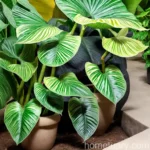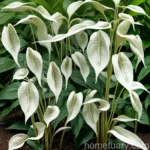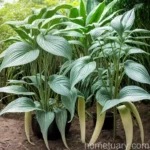Plant Scientist’s Guide to Dumb Cane (Dieffenbachia seguine)
Dieffenbachia, commonly known as dumb cane, is a beautiful and popular houseplant known for its large, broad leaves with stunning patterns. It belongs to the Araceae family and is native to the tropical regions of America. Dieffenbachia plants are favored for their air-purifying properties and their ability to thrive indoors, making them a popular choice for indoor gardens and offices. In this comprehensive guide, we will explore the essential aspects of caring for dumb cane (Dieffenbachia seguine) including its culture, uses, water requirements, sunlight needs, fertilizer application, soil preferences, pruning techniques, propagation methods, common diseases, and pest control strategies. Additionally, we will delve into fun facts, botanist’s tips, and links to external resources for further reading.
What is Dumb Cane (Dieffenbachia seguine)?
Dumb cane, scientifically known as Dieffenbachia seguine, is a genus of perennial, herbaceous plants that are treasured for their striking foliage. The name “dumb cane” is derived from the plant’s toxic sap, which can cause temporary loss of speech if ingested, leading to a sensation of the tongue and throat becoming swollen and numb. This is due to the presence of needle-shaped crystals of calcium oxalate present in the plant’s sap.
Dumb cane plants are characterized by their large, variegated leaves and are often cultivated as ornamental houseplants. They are native to the New World Tropics, primarily found in regions of Central and South America, and are well-adapted to the warm and humid conditions of tropical rainforests. The genus includes a wide variety of species, with Dieffenbachia seguine being one of the most popular and commonly cultivated varieties.
Key Takeaways – Dumb Cane (Dieffenbachia seguine)
Before delving into the specifics of caring for dumb cane, let’s review the essential takeaways to keep in mind:
- Common Name: Dumb Cane
- Scientific Name: Dieffenbachia seguine
- Toxicity: The plant sap is toxic and can cause symptoms when ingested.
- Characteristics: Large, variegated, broad leaves with striking patterns.
- Uses: An ornamental houseplant with air-purifying properties.
- Cultural Preferences: Requires indirect sunlight, well-draining soil, and regular watering.
- Propagation: Can be propagated through stem cuttings.
- Pests and Diseases: Susceptible to common houseplant pests and diseases; proper care can prevent and mitigate these issues.
- Popular Varieties: There are numerous cultivars with varying leaf patterns and colors.
- External Resource Links: Refer to external resources for in-depth information on caring for dumb cane.
Now, let’s dive into the specifics of cultivating and caring for dumb cane (Dieffenbachia seguine).
Culture
Understanding the cultural preferences of dumb cane is essential for providing the ideal environment for its growth and development. This encompasses various factors such as watering, sunlight exposure, soil composition, fertilization, and pruning requirements.
Uses
Dumb cane plants are primarily cultivated as ornamental houseplants due to their attractive foliage. However, they also serve the purpose of indoor air purification. The plant’s broad leaves have been found to effectively remove toxins from the air, making them a popular choice for enhancing indoor air quality.
Water
Proper watering is essential for the health and vitality of dumb cane plants. Overwatering can lead to root rot, while underwatering can cause the leaves to wilt and the plant to suffer. It’s crucial to strike a balance and ensure that the soil remains consistently moist but not waterlogged.
Sunlight
Dumb cane plants thrive in bright, indirect sunlight. While they can tolerate lower light conditions, exposing them to direct sunlight for extended periods can lead to leaf scorching. Positioning them near a window where they can receive filtered light is ideal.
Fertilizer
Regular fertilization is necessary to support the growth of dumb cane plants. Using a balanced, water-soluble fertilizer at half strength once a month during the growing season (spring and summer) can provide the necessary nutrients for healthy foliage development.
Soil
The ideal soil for dumb cane is a well-draining potting mix that retains moisture while allowing excess water to drain away. A blend of peat, perlite, and organic matter can create an optimal growing medium for the plant.
Pruning
Pruning is essential for maintaining the appearance and health of dumb cane plants. Removing yellowing or damaged leaves and periodically trimming back overgrown stems can promote new growth and keep the plant tidy and visually appealing.
Propagation
Dumb cane plants can be propagated through stem cuttings. By taking a section of the stem with at least one node and placing it in water or a rooting medium, new roots will develop, resulting in a new plant.
Container Popularity
Dumb cane is particularly well-suited for indoor containers, adding a touch of tropical elegance to interior spaces. It is commonly featured in homes, offices, and public buildings due to its lush foliage and air purification capabilities.
Common Diseases
Dumb cane plants are susceptible to a few common diseases that can affect their overall health and appearance. Understanding these diseases and their diagnosis is crucial for implementing appropriate treatment measures.
Disease Diagnosis
The following are some common diseases that may affect dumb cane plants:
– Leaf Spot: Circular spots on the leaves, often caused by fungal infections or bacterial pathogens.
– Leaf Curling: Abnormal curling of the leaves, which can be indicative of various issues including pests, diseases, or environmental stress.
– Leaf Dropping: Premature dropping of leaves, often caused by overwatering, underwatering, or environmental changes.
Diagnosing the specific cause of these symptoms is essential for implementing targeted treatment strategies to restore the plant’s health.
Common Pests
Like many houseplants, dumb cane plants are vulnerable to attacks by various pests that can compromise their health and vitality. Identifying and addressing these pests promptly is crucial for maintaining the plant’s well-being.
Pest Control
Some common pests that may affect dumb cane plants include:
– Spider Mites: Tiny pests that can cause stippling and webbing on the leaves, leading to significant damage if left untreated.
– Mealybugs: White, cottony pests that can cluster on the leaves and stems, sapping the plant’s vitality.
– Aphids: Small, soft-bodied insects that can gather on new growth, causing distortion and damage to the plant.
Implementing pest control measures such as regular inspections, manual removal of pests, and applying natural or chemical solutions as appropriate can help mitigate pest infestations and protect the plant.
Botanist’s Tips
As a botanist specializing in houseplants, I’ve gathered some valuable insights and tips for cultivating and caring for dumb cane plants.
- Humidity: Dumb cane plants thrive in relatively high humidity. To create a favorable environment, consider using a humidifier, placing the plant on a pebble tray filled with water, or regularly misting the leaves to increase humidity levels.
- Toxicity Awareness: Due to the plant’s toxic sap, it’s essential to handle dumb cane with care and keep it out of reach of children and pets to prevent accidental ingestion.
- Temperature Tolerance: While dumb cane plants prefer warm and humid conditions, they can tolerate typical indoor temperatures. Avoid exposing them to cold drafts or extreme temperature fluctuations.
By incorporating these tips into your care routine, you can enhance the well-being and longevity of your dumb cane plant.
Fun Facts
Dumb cane plants have several interesting attributes and characteristics that make them stand out as captivating additions to indoor spaces. Let’s explore some fun facts about this fascinating plant species:
- Cultural Significance: In some cultures, dumb cane plants are believed to bring good luck and prosperity, making them popular choices for homes and businesses.
- Varietal Diversity: There are numerous cultivars of Dieffenbachia seguine, each with its unique leaf patterns and colors, ranging from creamy whites and vibrant greens to rich, deep hues.
- Air Purification: Dumb cane has been recognized for its air-purifying capabilities, effectively removing harmful toxins such as formaldehyde and xylene from indoor environments.
- Historical Uses: In traditional herbal medicine, extracts from dumb cane plants have been used for various purposes, including treating minor ailments and skin conditions.
These fun facts add to the allure of dumb cane plants, showcasing their botanical significance and cultural relevance.
Links to External Resources
For further information on caring for dumb cane (Dieffenbachia seguine), I recommend exploring the following external resources:
- Royal Horticultural Society – Growing Dumb Canes
- University of Florida IFAS Extension – Dumbcane, Dieffenbachia spp.
- The Spruce – Dumb Cane Plant (Dieffenbachia): Care and Growing Guide
These resources offer in-depth insights and practical guidance on various aspects of dumb cane care, catering to both novice and experienced plant enthusiasts.
In conclusion, dumb cane (Dieffenbachia seguine) is a captivating and versatile houseplant that adds a touch of tropical elegance to indoor spaces. By understanding its cultural preferences, implementing proper care practices, and staying informed about potential diseases and pests, you can cultivate thriving and vibrant dumb cane plants. Remember to leverage the provided resources for additional guidance and immerse yourself in the rewarding world of caring for this enchanting botanical specimen.
By nurturing your dumb cane plant with attentiveness and care, you’ll witness its lush foliage and air-purifying properties enhance your living or working environment, making it a delightful addition to any indoor setting.
With the comprehensive information provided in this guide, you are well-equipped to embark on an enriching journey of cultivating and caring for dumb cane (Dieffenbachia seguine). Happy gardening!















